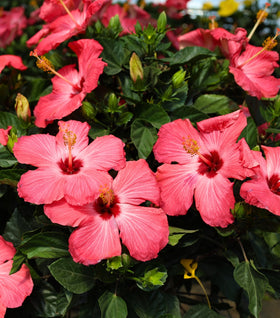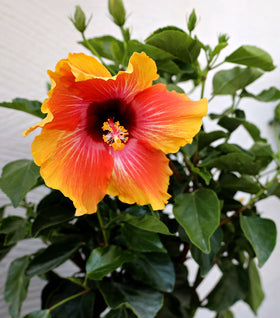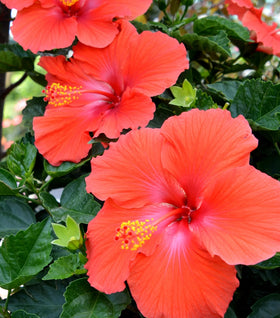Tropical Hibiscus Plants
Native to Asia, tropical hibiscus plants are known to bring dramatic, vibrant flowers into your home year-round. Their trumpet-shaped blooms are typically 3 to 8 inches large and last a short time but don't worry; they are producing flowers constantly! This fast-growing plant can be used outdoors in proper growing zones but is often used as a houseplant. Lucky for you, your loved ones, and your pets, this houseplant is non-toxic and will not cause any harm or damage.
Hibiscus prefers to be placed in full sun to partial shade, moist but well-draining soil conditions, and semi-acidic soil ph levels. Tropical hibiscus plants are fairly easy to take care of as long as they receive plenty of light and water. Watch your home come to life with a beautiful and vibrant hibiscus plant!
How To Care for Hibiscus
Water
Tropical Hibiscus plants are known to be very thirsty plants and only produce blossoms if given enough water. We recommend giving your tropical plant two to three inches of water each week. If you live in a warm climate and your Hibiscus is outside, you may need to water it once a day, up to twice a day. If you notice leaves dropping or yellowing towards the top, chances are it's not receiving enough water. However, if you notice the yellowing of the leaves more in the middle, you are probably overwatering your plant. It is all about finding a happy medium when watering Hibiscus plants.
Light
Depending on what climate you live in, your Hibiscus will require different light exposures. If you live in southern climates or somewhere that is more hot and dry, your plant will thrive in a partially shaded area. This kind of light will give your plant some time to relax and be away from bright afternoon sunlight. However, if you live in a more northern climate, your Hibiscus will love to live in full sun. The cooler weather will allow for your plant to soak up all the sun without too much worry of damaging your plant. If you notice your Hibiscus is not producing buds and flowers, move it into an area with more sunlight.
Soil
If your Hibiscus is in a container, we recommend using a well-draining potting mix, preferably one formulated specifically for tropical plants. The well-draining soil will allow your plant to soak up only the water they need and no more than that. If your plant soaks up too much moisture, it could cause root rot disease. If you are planting your Hibiscus outdoors, your soil should contain lots of organic matter. This soil should also be well-draining to avoid any risk of root rot.
Fertilizer
We recommend feeding your Tropical Hibiscus with a diluted fish emulsion fertilizer. This type of feed will help keep your plant blooming beautiful and vigorous flowers their entire growing season. Always give your plant a thorough watering after fertilizing so that it all can absorb evenly, and you don't risk burning the plant's roots from too much fertilizer. Also, avoid giving your plant fertilizer in the winter months, this is their dormancy period, and it is unnecessary to feed them during this time.
Potting
When choosing a pot for your plant, it is best to find one that is not too deep because it could stunt your Hibiscus flower production. This will happen because your plant will spend more time on root development and less time producing flowers. Any wide but shallow pot is perfect. Always choose a container with drainage holes to ensure your plant does not run into root rot risks. You can also add a layer of rocks at the bottom of your container for added drainage.
How To Propagate a Tropical Hibiscus Plant
Soft-stem cuttings are an easy way to propagate your Hibiscus. The best time to propagate your Hibiscus is in late spring after the plant has begun actively growing for the season. Always keep the cutting out of direct sunlight, and it may even help to bag the cutting to preserve moisture and retain heat for humidity while the roots establish.
Types of Hibiscus
Hollywood Hibiscus
- Hollywood First to Arrive Hibiscus Bush
- Hollywood Hot Shot Red Hibiscus Bush
- Hollywood Chatty Cathy Yellow Hibiscus Bush
Tropical Hibiscus
- Pink Tropical Hibiscus
- Tropical Fiesta Hibiscus
- Red Tropical Hibiscus
- Paradise Hibiscus
- Tropical Hibiscus Tree




